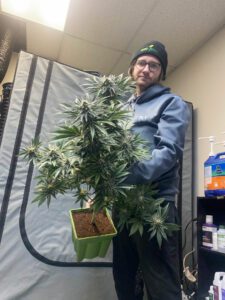“Terpenes are so important because they are one of the driving factors in the experience you are going to have with most cannabis products.” — Paul Fish
Terpenes are found in a lot of the common foods we eat and much of the nature we see: fruit, vegetables, plants, trees, flowers, etc. They are known as the ultimate modulator of the cannabis plant with powerful benefits, and are the largest class of natural compounds.
In cannabis, terpenes are secreted in the same glands that produce THC, CBD, and other cannabinoids.Terpenes are oils, much like other oils that you are already familiar with like peppermint, eucalyptus, and tea tree. Terpenes provide cannabis strains with distinctive flavors like citrus, berry, mint, and pine.
Focus on terpene production in cultivation is important because they are key for the entourage effect. This is what science is now calling the positive contribution derived from the addition of terpenes to the effect of cannabinoids; in short, how cannabinoids and terpenes work together.
For more information on terpene production, we asked Paul Fish for his insight. Paul is the cofounder of Wunderkind, lab manager and head of R&D and formulations for Peacock Labs, owner of a retail hydroponics store called Hydrokulture with locations in Fredericksburg and Manassas, Virginia, and a home cultivator for five years.

Why are terpenes an important focus in cannabis consumption?
They are important because all of these different effects we see from different strains come from your terpenes and minor cannabinoids, whether it’s drowsy/sleepy or uplifted and focused. Many consumers aren’t aware of this.
On a scale from 1 to 10, how important is it for cannabis cultivators to focus on terpene production and why?
It’s a 10, because we are finding that terpene content is one of the driving factors when it comes to the experience you are going to have smoking cannabis. And I’m not just talking about the effects, but the taste and smell too.
As this market regulates itself, you are going to see cultivators who are growing the more terpy cannabis succeed over those with just high THC. It’s important to understand what terpenes do, and understand each one. Knowing is super beneficial for crafting a menu because more options can be offered and that will help give cannabis consumers and patients more of what will actually help them.
For instance if someone with high anxiety is looking for a strain to relax, you would want to be able to give them something high in myrcene and linalool and maybe a bit lower in THC.

This is a pretty commonly debated question which I believe needs more research, but yes. We have commonly found that living soil mediums tend to produce higher terpene content. It is a more costly way to grow but you see big commercial companies running full living soil rooms, and they aren’t doing all that work for nothing.
When using living soil, the cultivators aren’t just power feeding the plant, they are using a vast team of microorganisms along with organic nutrients to give the plant what it wants when it wants it. This creates an environment for plants to thrive and grow big, healthy root systems.
I think a lot of cultivators easily lose sight of this because they aren’t always looking at the roots, though they are the most important part of the cannabis plant.
Can you explain the possible or potential differences between terpene production in a 60-day grow cycle versus a 90-day grow cycle?
This is an interesting question and the answer is: It’s strain dependent. A lot of the strains being bred today are for 60-day flower time instead of 90. In general, when it comes to commercial cultivation, everyone is looking at how they can maximize profits while the consumer cost of cannabis is steadily going down.
Because many breeders are hunting for those faster flowering strains, it would be interesting to study how faster flowering times affect terpene production. This isn’t a subject I’ve seen mentioned very much or seen any research on but, now I’m interested in running my own trials on the subject.
Most longer flowering strains are going to be closer in lineage to the landrace strains we originally started with, which are known to be extremely pungent in smell so there may be something there.

